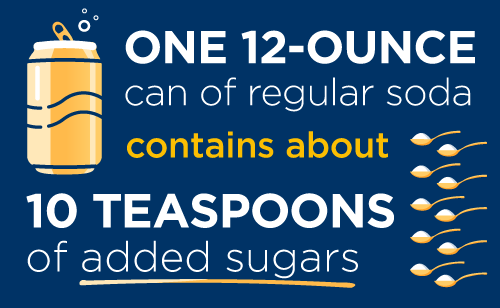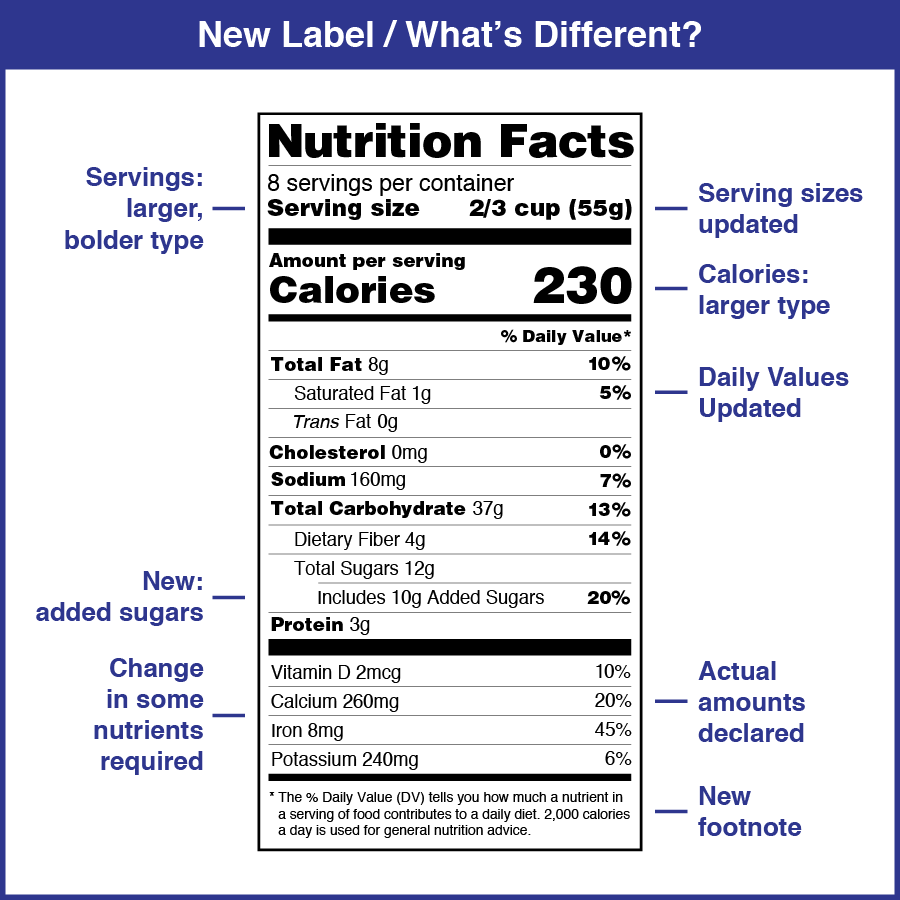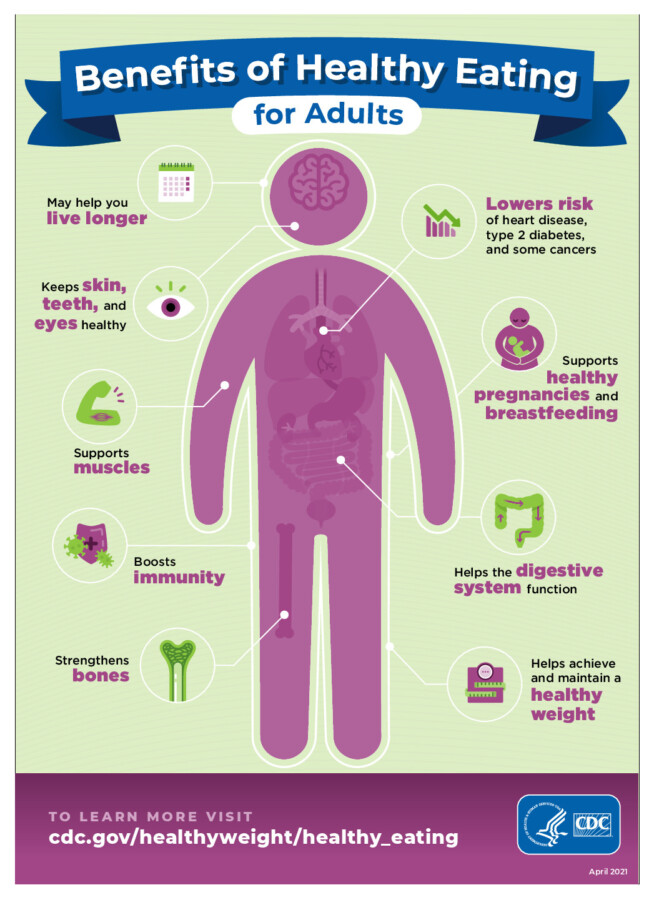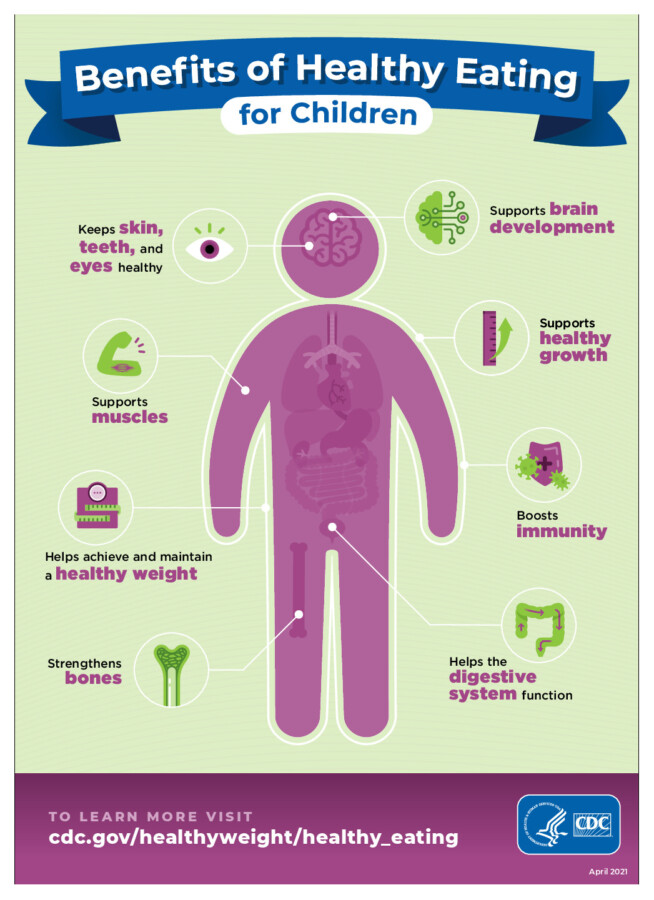Free Resources for Healthy Eating
A healthy diet helps children grow and develop properly and reduces their risk of chronic diseases. Adults who eat a healthy diet live longer and have a lower risk of obesity, heart disease, type 2 diabetes, and certain cancers. The Wellness Coalition provides nutrition tips and resources to help you and your community learn new ways to improve wellness, including:

Benefits of Healthy Eating
Healthy eating can help people with chronic diseases manage these conditions and avoid complications. Healthy eating emphasizes fruits, vegetables, whole grains, dairy, and protein. Dairy recommendations include low-fat or fat-free milk, lactose-free milk, and fortified soy beverages. Other plant-based beverages do not have the same nutritional properties as animal’s milk and soy beverages. Protein recommendations include seafood, lean meats and poultry, eggs, legumes (beans, peas, and lentils), soy products, nuts, and seeds.
Healthy eating for adults:
Healthy eating for adults:
Healthy eating for children:
Healthy eating for children:
Eating Healthy On a Budget
Eating on a budget doesn’t mean you have to sacrifice nutrition. With a little know-how and planning, you can enjoy nutritious foods without breaking the bank. And if you need help, a diabetes care and education specialist can work with you to develop a plan that fits your lifestyle, beliefs, and culture. By following these six tips, you may be surprised at how much you can stretch your grocery budget.
Get Free Cookbooks for Budget Meals
Planning ahead allows you to think about your food needs, tastes, and budget. If you know you have to stretch your money for the week, meal planning can really pay off.
- Good and Cheap is a cookbook by Leanne Brown for people with very tight budgets, particularly those on SNAP/Food Stamp benefits. Click to download the free PDF.
- ChooseMyPlate.gov has developed a free downloadable cookbook for those on a very tight budget. This book not only shares great affordable recipes, but also has educational information about how what you eat impacts your body and health. Click to download the free PDF.
Adapt Recipes to Fit Your Needs
A diabetes care and education specialist can customize your diabetes diet for your specific needs. Choosing meals that help manage your blood sugar is key to managing your diabetes. If you love pasta dishes, but your diabetes meal plan has you following a low-carb diet, you can search recipes that use veggie noodles instead of traditional noodles. These are great alternatives to increase your vegetable intake and keep your blood sugar from spiking.
Use Common Ingredients
Using the same ingredients for multiple meals doesn’t mean they all have to taste the same. Using different herbs and spices can turn common ingredients into meals with different flavors. If your favorite protein is chicken, cook one whole chicken and use it for several different dishes. You can have chicken and vegetable stir fry one night and chicken fajitas another night.
Stretch a Recipe
You can stretch meals by making dishes that freeze well. Search online for delicious healthy recipes like soups and casseroles that are budget-friendly and easy meals to stretch. For example, make a large batch of vegetable soup or white bean chicken chili that can last throughout the week, or freeze the leftovers to have later. You’ll also spend less time in the kitchen than if you make a different meal every night.
Planning your weekly menu also increases the chance that your pantry and refrigerator are stocked with healthy ingredients to make balanced meals that help you maintain your blood sugar levels.
Shop With A List
Once you’ve planned your meals for the week, create a shopping list with the ingredients you need. Having a shopping list makes shopping easier and faster, which helps you reduce impulse buys and take home only the items you need. It also helps you avoid extra trips to the grocery store to buy forgotten items.
If your shopping list includes nuts, beans, or grains, consider buying in bulk to save money and keep your pantry well-stocked for future meal planning.
Buy Frozen or Canned
When it comes to fruits and vegetables, frozen and canned options can be healthy alternatives to fresh produce. What’s more, they cost less and last longer. Many frozen veggies and fruits even have resealable packaging that allows you to use what you need and store the rest. This way you can enjoy your favorites even when they aren’t in season.
When choosing canned options, it’s best to select those that come in water, not syrup. Be sure to read the label for any added sugar or salt. You’ll want to avoid those. And skip frozen options that have added butter or cream sauces. Choose options without sauce or look for packaging that reads “lightly sauced” to avoid extra sugar, salt, and empty calories.
Cut Cost With Coupons
Coupons are a great way to save on your grocery bill, especially if you have your shopping list planned out. You can search for online coupons for the ingredients on your list.
With over a billion coupons available each year, you will likely find a coupon that you can use. If you can’t find a coupon for those blueberries on your list but find one for strawberries, consider making the swap to save money. Even low-value cents-off coupons can really add up. Just by using five 50-cents-off coupons a week, you can end up saving over $100 each year.
Buy Store Brands
Buying generic or store brand items can save you 20% to 30% on your food bill. Items like canned tomatoes, milk, olive oil, and frozen fruits and vegetables are usually available in a cheaper store brand version.
Just be sure to compare the ingredients list and nutrition facts panel to make sure you’re not getting a product with added ingredients. Learning which store brands your grocery store carries can help you reduce your total at the cash register.
Try Growing a Garden
If you can, growing your own fruits and vegetables is a great way to save money and have fresh produce at your fingertips. Even if you don’t have a yard to grow a garden, many fruits, vegetables, and herbs can grow in pots on patios or balconies.
Having a constant supply of fresh produce at home can save you money at the store. You may not be able to grow a “money tree” in your garden, but it’ll feel like you did with the extra money you’ll be saving.
Click here for tips on how to create a garden.
Reading and Understanding Nutrition Facts Labels
The Nutrition Facts label on packaged foods is based on updated science and dietary recommendations for Americans. Using the label can help you choose foods for a healthy diet. The label is required on all packaged foods made in the United States and imported from other countries. Here are a few tips, based on the Dietary Guidelines for Americans, 2020-202, to help you make healthier choices about what you eat and drink:
Reading Labels
Read the Nutrition Facts labels on your packaged food and drinks to keep track of sugars, fats, protein, and other nutrients.
Added Sugars
Keep your intake of added sugars to less than 10% of your total daily calories. That means if you consume 2,000 calories in a day, added sugars should account for no more than 200 calories.
Sodium
Most sodium we consume is from salt, and salt is commonly in processed foods. Read labels and choose the product with less sodium.
Drinks
Drink plain water instead of sugary beverages. Read the product’s Nutrition Facts label and rethink your drink.
Treats
Limit the serving size of the treats. If you are going to have dessert, keep it small.
Serving Sizes
Be sure you know how many servings are in food. For example, if you buy what looks like an individual sized chicken pie, check the Nutrition Facts label. It might actually be two servings. If you eat the whole pie, you will eat twice as many calories and twice as much sodium listed on the label.

Rethink Your Drink
Sugary drinks are the leading source of added sugars in the American diet. These sweetened liquids include regular soda, fruit drinks, sports drinks, energy drinks, and sweetened waters. The flavored coffees we grab on the way to work and sweet drinks we order when eating out also count as sugary drinks. Adding sugar and flavored creamer to coffee and tea at home counts, too.
The next time you go grocery shopping, read the nutrition labels on the items in your cart to see which ones have the most added sugars. You may be surprised to see the amount of added sugars in some drinks.
Amount of Sugar and Calories in Common Drinks
| Drinks(12 oz serving) | Teasppon of Sugar | Total Drink Calories |
|---|---|---|
| Tap or Unsweetened Bottled Water | 0 | 0 |
| Unsweetened Tea | 0 | 0 |
| Lemonade, powder, prepared with water | 3 | 55 |
| Sports Drinks | 5 | 97 |
| Brewed Sweet Tea | 7 | 115 |
| Energy Drink | 9 | 162 |
| Regular Soda | 10 | 155 |
| Fruit Juice Drink | 10 | 186 |
| Regular Orange Soda | 13 | 195 |
Getting enough water every day is important for your health. Of course, there are many other beverage options besides water, and many of these can be part of a healthy diet. Here are some benefits to water and tips for other healthier drink options.
Handouts
- Customizing Dietary Guidelines
- Cut Down on Saturated Fat
- Cut Down on Sodium
- Cut Down on Added Sugars
- Eat Your Colors
- How to Make Your Plate
- Freezing Summer Produce
- Making Better Choices When Eating Out
- Myths and Facts About What You Drink
- Six Meals From One Chicken
- Sugar Shock
- The Sour Truth About Sweet Drinks
Additional Resources
Made possible with funding from the Centers for Disease Control and Prevention.
Handouts
- Customizing Dietary Guidelines
- Cut Down on Saturated Fat
- Cut Down on Sodium
- Cut Down on Added Sugars
- Eat Your Colors
- How to Make Your Plate
- Freezing Summer Produce
- Making Better Choices When Eating Out
- Myths and Facts About What You Drink
- Six Meals From One Chicken
- Sugar Shock
- The Sour Truth About Sweet Drinks
Additional Resources
- Breastfeeding Nutrition (link to breastfeeding resource page)
- Community Gardens
- Dietary Guidelines for Americans
- Eat Well on $4/Day Cookbook
- Healthy Corner Stores
- Healthy Eating for a Healthy Weight
- Healthy Foods on the Montgomery Bus Line
- Meeting Your MyPlate Goals on a Budget
Made possible with funding from the Centers for Disease Control and Prevention.






